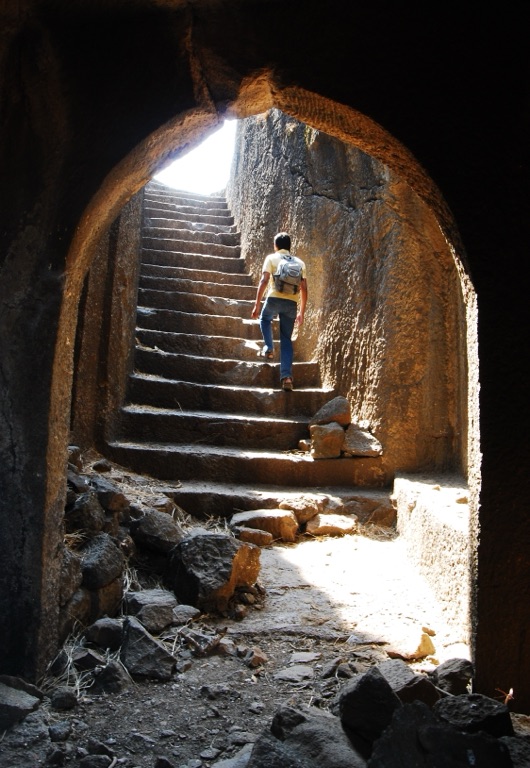Hadsar Fort, nestled in the Sahyadri mountain range of India, stands as a testament to the grandeur of Maratha architecture and the region’s rich history. This hill fort, located in the state of Maharashtra, was an important stronghold during the Maratha Empire. It boasts a unique design, with impressive fortifications and water cisterns, reflecting the ingenuity of its builders. The fort’s strategic location and construction played a crucial role in the defense against invading forces, making it a significant historical and architectural marvel.
Get your dose of History via Email
Historical Background of Hadsar Fort
The discovery of Hadsar Fort dates back to the era of the Maratha Empire, although the exact details of its discovery remain unclear. Built on a hilltop, it was designed to serve as a watchtower, overseeing the trade routes passing through the region. The fort’s construction is attributed to the Satavahana dynasty, which ruled from the 2nd century BCE to the 2nd century CE. However, it gained prominence during the reign of the Maratha ruler Shivaji Maharaj in the 17th century.
Shivaji Maharaj, known for his strategic acumen, recognized the fort’s military significance and included it in his kingdom’s defense network. Hadsar Fort later became a site of intense battles, particularly during the Maratha wars. Its robust design and strategic position made it a tough nut to crack for invading armies. The fort has witnessed several sieges and has changed hands multiple times, reflecting the turbulent history of the region.
After the decline of the Maratha Empire, Hadsar Fort fell into obscurity and disrepair. It was not until recent times that the fort caught the attention of historians and archaeologists, who recognized its historical value. Efforts have been made to preserve the fort’s remnants, which continue to attract history enthusiasts and trekkers alike.
The fort’s architecture suggests that it was built to withstand long sieges. It features two main gates, seven water cisterns, and several storage rooms. The fortifications are still intact in many places, offering a glimpse into the past. The presence of temples within the fort indicates that it was not only a military installation but also a place of worship and community gathering.
Today, Hadsar Fort stands as a silent witness to the past, its ruins telling stories of bravery, strategy, and the resilience of the Maratha people. It serves as a popular destination for trekkers and history buffs, who climb its steep slopes to experience a piece of India’s rich heritage.
About Hadsar Fort
Hadsar Fort, perched atop a hill at an elevation of about 3200 feet, is a marvel of ancient engineering. The fort’s main entrance is an architectural spectacle, featuring a unique rock-cut stairway that leads to a tunnel-like entrance. This design was intended to confuse and slow down enemy forces attempting to breach the fort.
The fort’s walls, built from the indigenous basalt rock, have withstood the test of time. The use of local materials not only provided strength but also helped the structure blend with the surrounding landscape, making it less conspicuous to enemies. The fortifications include bastions and ramparts, which were crucial for the defense against invaders.
One of the architectural highlights of Hadsar Fort is its water management system. The fort contains several water cisterns carved out of solid rock, which ensured a steady supply of water during sieges. These cisterns are a testament to the advanced hydrological understanding of the fort’s builders.
Inside the fort, one can find the remnants of old structures, including granaries, armories, and living quarters. These structures, though now in ruins, provide insight into the daily life of the fort’s inhabitants. The presence of temples dedicated to Hindu deities within the fort’s premises indicates the integration of religious and military functions.
The fort’s layout, with its strategic vantage points and hidden exits, showcases the military strategy employed by its builders. The design allowed the defenders to monitor and control the surrounding region effectively. Today, the fort’s ruins continue to fascinate visitors with their blend of natural beauty and historical significance.
Theories and Interpretations
Several theories surround Hadsar Fort, particularly regarding its original purpose and the extent of its use. Some historians suggest that the fort was initially built as a monastic retreat before being repurposed for military use. The presence of ancient caves nearby supports this theory, indicating the area’s significance as a spiritual center.
Another theory posits that Hadsar Fort was part of a larger network of forts designed to protect the trade routes that crisscrossed the region. This interpretation is backed by the fort’s strategic location, which offers a commanding view of the surrounding terrain.
Mysteries also shroud the fort, such as the purpose of certain architectural features that do not have clear military or residential functions. Some speculate that these features may have been used for astronomical observations or as secret meeting places.
Historical records and archaeological findings have been used to interpret the fort’s past. Inscriptions and artifacts found at the site have provided valuable information, helping historians piece together the fort’s history. However, much of the fort’s story remains untold, inviting further research and exploration.
Dating of the fort has been carried out using various methods, including carbon dating of organic materials found at the site. These studies have helped establish a timeline for the fort’s construction and use, although some periods remain less understood than others.
At a glance
Country: India
Civilization: Satavahana Dynasty, later Maratha Empire
Age: Originally built in the 2nd century BCE, gained prominence in the 17th century CE
Conclusion and Sources
Reputable sources used in creating this article:
- Wikipedia – https://en.wikipedia.org/wiki/Hadsar

